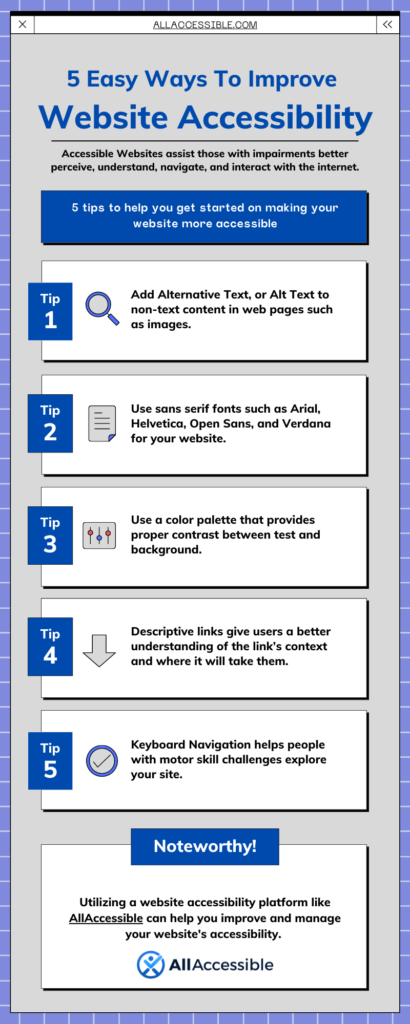
Over the past 30 years, the rise of the internet has made an organization’s website a cornerstone of its business. Today, the majority of consumers will visit an organization’s website before making a purchase or signing up for a service. So, the adage that “Every Business Needs a Website” is true but incomplete. The true axiom should be “Every Business Needs an Accessible Website.”
Website Accessibility means that websites, and web based technologies are designed and developed so that people with disabilities can use them. Websites developed with accessibility in mind assist those with impairments better perceive, understand, navigate, and interact with the website.
In addition to the fact that Website Accessibility is the law in most countries, there are some serious business impacts to making your website more accessible. There is no doubt that committing to an accessible website will help improve your brand identity but there is more to it than that. The American Institutes for Research estimates that in the US alone, approximately 26% of the population has a disability, and that population has disposable income of roughly $504 billion. This indicates that one quarter of the customers your organization serves has a disability, whether or not those disabilities are apparent. Worldwide that estimate jumps to nearly 1 billion people (roughly 15% of the world population) with disabilities with a combined buying power in the trillions of dollars. A more accessible website will help your organization connect with a larger audience by tapping into the global market of people with disabilities.
Clearly, Website Accessibility is important to any organization. Here are 5 easy steps to help you improve your website’s accessibility.
1) Alt Text
Alternative Text, or Alt Text is a textual substitute for non-text content in web pages such as images. Alt Text is especially important for website accessibility because the Alt Text descriptions are read aloud to blind users on a screen reader. When developing your Alt Text descriptions it is important to keep the following guidelines in mind:
- Accurate: Make sure the text is accurate when representing the content or function.
- Concise: Be succinct as possible when presenting the content or function.
- Avoid Redundancy: Avoid providing the same information that is in the website text.
- Avoid Redundant Phrasing: Do not include phrases like “image of ” or “graphic of”.
2) Accessible Font
Font type can have a large impact on your site’s accessibility. Certain fonts, particularly serif fonts, can be difficult to read for people with dyslexia or visual impairments.Opt for using sans serif fonts such as Arial, Helvetica, Open Sans, and Verdana for your website. There are also fonts that have been designed specifically for accessibility such as Tiresias and OpenDyslexic.
3) Accessible Color Palette
A color palette that provides proper contrast between test and background is a critical element of website accessibility. The ideal contrast ratio is greater than or equal to 4.5:1 for small text and 3:1 for large text. There are free tools to help you get this right including:
4) Descriptive Links
Much like Alt Text, the links on your page play an important role on how people with screen readers interact with your website. Descriptive links give users a better understanding of the link’s context and where it will take them. Extraneous words used as links such as; “click here” or “more” should be avoided where possible.
5) Keyboard Navigation
Keyboard Navigation helps people with motor skill challenges explore your site. Users should be able to access and move between links, buttons, forms, and other controls using the Tab key and other keystrokes. Native HTML controls, such as links, buttons, and form elements, work with the keyboard by default and should be used where possible. Custom controls, CSS styles, and scripts that control interaction may need additional coding for keyboard compatibility. It is important to ensure that your reading / navigation order is correct.

This is by no means a comprehensive list, but by following these guidelines, you will be able to improve your site’s accessibility and reach a larger audience.
As you begin your website accessibility journey, be sure to utilize a website accessibility platform like AllAccessible. AllAccessible can help you improve and manage your website’s accessibility.


